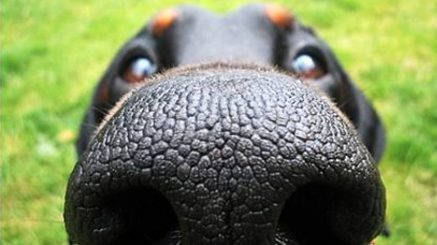
Conventional wisdom is that dogs are color blind, and that they can smell and hear better than we can. While we can’t ask my dog “Finn” if that is true , there are many facts we do know. Dogs are not color blind, but they see colors differently than we do. How do we know that? As you may remember from biology there are two main receptor cells in the retina – the rods and the cones. Dogs have a greater percentage of rod cells which are the black and white receptors. These cells are much more sensitive in low light. Dogs cannot see in total darkness, but they are much more sensitive than we are in dim conditions. They also have a reflective layer behind the retina which helps in low light. That layer is why their eyes seem to glow when light bounces off of them. (Like when the flash of the camera hits them).
What about color vision? Dogs do have cone cells to pick up color. There are different types of cones, however, that are sensitive to different colors. By studying these cells we know that dogs see blue and green the best. Colors look different to them than to us.
Can dogs hear better than we do? Certainly they can hear higher frequencies than we do. This is why dog whistles work, and it may be a reason they sense things like thunder storms before we do. We hear about as well as dogs do in the frequency range where our hearing overlaps with theirs. Who listens better I will leave up to you.
If we turn our attention to olfaction (sense of smell), dogs leave us in the dust. We have no conception of their sense of smell. In fact, a dog like a Labrador Retriever has more than 200 million olfactory receptors in its nose while humans have only 5 million.(I don’t know who counted them!) This is a factor of 40 times more cells! No wonder they have to sniff every bush, fire hydrant, and other dog. I have seen different estimates of how faint an odor a dog can sense, but if you put a teaspoon of sugar in an Olympic size swimming pool – they know it is there.
For generations man has taken advantage of the dog’s keen sense of smell for tracking and for hunting. Now dogs are routinely used to smell for drugs, bombs, and in search and rescue situations. One of the newer advances is to use the dog’s sense of smell to detect or monitor diseases of people. Dogs are being trained to monitor the blood sugar of diabetics, as well as to monitor epileptics for seizures. Researchers are even working to teach dogs to detect some cancers by smell. (pretty soon you may have a dog scan instead of a CAT scan).
To learn more on dogs and their senses check the book Inside of a Dog by Alexandra Horowitz for much more detailed information.
